by Quilt Alliance | May 16, 2014 | Alliance Quilt Contests, QSOS, Quilt Index
The deadline for our annual quilt contest is two weeks away–“Inspired By” entries must be postmarked by June 1, 2014. Full details including a downloadable entry form can be found on our website and blog. If your design or execution are still in neutral, here is a little inspiration game to get your motor in gear. Match the Quilt to the Alliance Board Member Five Quilt Alliance board members have offered photos of their in-progress or finished Inspired By entries: Allie Aller Lisa Ellis Luke Haynes Michele Muska Victoria Findlay Wolfe See if you can match up the artist with the quilt! In the left hand column below are the Inspiration quilts, selected from The Quilt Index or Q.S.O.S., and on the right are the original contest entries. Post your answers here as comments (A=board member’s name, etc…), and we’ll draw a winner on Monday, May 19 at 5pm Eastern from all those with correct answers.
-
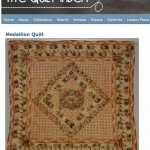
-
A. Medallion Quilt. c.1830. Quilts of Tennessee
-
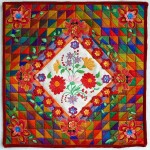
-
?
-
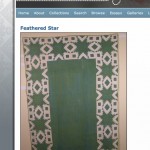
-
B. Feathered Star by Mariette Pierce, 1800-1849, DAR Museum.
-

-
?
-

-
C. “Aletsch” by MIchael James, 1990, National Quilt Museum.
-
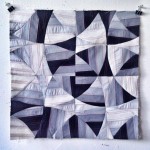
-
?
-
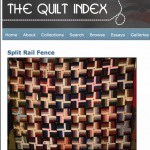
-
D. Split Rail Fence. 1901-1929. Michigan Quilt Project.
-
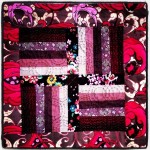
-
?
-
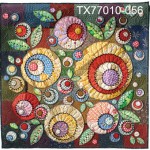
-
E. “Scrap Bag Bouquet” by Tom Russell. 2011 Q.S.O.S. interview.
-
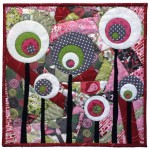
-
?
-

-

-
http://www.equilter.com/
-

-
http://www.modafabrics.com/
-

-
http://www.aurifil.com/
-

-
http://electricquilt.com/
-

-
http://www.ezquilt.com/
-

-
http://www.simplicity.com/
-

-
http://www.sewingexpo.com/
-

-
http://stkr.it/
-

-
http://www.threadsmagazine.com/
by Quilt Alliance | Mar 30, 2014 | QSOS, QSOS Spotlight, Uncategorized
There are many, many Q.S.O.S. interviews that contain stories of quilts being passed down, through families, and traveling across generations along family lines. But this week’s Q.S.O.S. Spotlight features a quilt that traveled around a family in a different way, when it was sold in a family auction and then won again by quiltmaker Judy Baxter-Warrington. Her charming story of a family heirloom and its travels is our Q.S.O.S. spotlight this week: “This is a quilt that was made by three generations on my mother’s side of the family. Every year for our family reunion, almost every year, I make some form of a quilt to auction off and it helps pay for the reunion expenses, and other things that the family does throughout the year. This particular one I’d seen in a magazine, and I just fell in love with it, and I decided I would make it for that particular reunion. It was about two thousand and five I believe. I can clarify that when I actually bring the quilt. I worked on it for a long time. It’s got lots of pieces in it. It’s very colorful, but it’s done in eighteen thirties fabrics something that I wanted. I pieced it all and the week before the reunion attempted to quilt it. This quilt is suppose to be queen size but, as most of my projects end up being, it’s closer to a king size. [MM laughs.] So here I am, slinging this big quilt over my shoulder, trying to shove it through the machine, and the machine is giving way to the weight of the quilt. I think I got about six inches attempted to be quilted and decided I was not going to be able to get this one machine quilted. So I said, ‘Okay, I have to come up with another plan here folks.’ I took the quilt with me. I packed it all up and we went to Indiana. On my way there I came up with a plan. I decided rather than just tying the quilt, which is one of the traditional ways of finishing the quilt sandwich, I would tie it with buttons. There are tons of buttons all over this quilt. It’s tied with twill cotton sewn through the buttons. My mother, my daughter, and my granddaughter all helped me work with it. My granddaughter helped pick out the buttons and hand them to us. We were sewing the last buttons on the morning of the reunion. I had a real trauma because one of my cousins was the successful bidder on the quilt, and I hadn’t even had time to really, as most quilters will know that’s themselves in that quilt, and they need to touch it, and look at it, and show it to other people. I never got that opportunity to do that. We packed it up and drove back to Missouri with it. I didn’t get to see the quilt. It just went bye-bye. Just to tell a little bit on the side here, he and his then wife, in the following year I believe it was, they divorced. He took custody of the quilt. He brought it back two years ago, 2007, and put it back up for bid. This ornery cousin likes to bid against me at the family reunions. We’re near the same age. Everybody knew that I that I wanted to get my quit back. I had a budget because I didn’t have a lot of money. I had two hundred dollars that I could pay for it, although I knew it was worth a lot more than two hundred dollars. He kept bidding against me, cause he was maybe going to give it to one of his kids who had liked it. I said, ‘No, I wanted to take my quilt home and enjoy it for a little while before,’ maybe, giving it back and into the reunion kitty. At any rate, it hit two hundred and I was gulping, almost in tears. Another cousin, who understands this little game that gets played at the reunions, bid on it for me and bought it for me. [MM gasps.] So, I have it now on my bed at home. I love the quilt, although I’ve had it now for a while. Maybe not this year, but possibly next, I will take it back to reunion, let it travel on to another family to enjoy, now that I’ve had time to really absorb the quilt.” You can read more quilt stories on the Quilters’ S.O.S.- Save Our Stories page on the Quilt Alliance website. Posted by Emma Parker Project Manager, Quilters’ S.O.S.- Save Our Stories…
by Quilt Alliance | Mar 23, 2014 | QSOS, QSOS Spotlight
Today’s Q.S.O.S. Spotlight is shining on Teresa Alvarez of Boonville, California. Teresa was interviewed as part of the Los Hilos de la Vida Q.S.O.S. Project, which interviewed members of the mostly Latina ‘Lost Hilos de la Vida’ (Threads of Life) quilt group in Boonville, California. In her interview, Teresa explained the significance of her quilt–only the fourth one she’d ever made–and the importance of quilting in her life. “It is a work. We came to learn to quilt. We learned that we could do a lot of things. We learned how to draw, how to sew better. Learn how to express how one has lived, and what has happened to us and what is past…This quilt represents the border. So when somebody comes over the border they feel like they are in the dark. So, you come here having to better yourself, to get ahead. Tinkerbelle represents the light. The light represents–Tinkerbelle represents light and also the stars represent the light and of the home of the family to get ahead.” Karen Musgrave, interviewer: So what do you think of the group… Why is quilting important to you? “It gives us good opportunities. To learn art, to get rid of the stress of being in the house allthe time. To have something to relieve the house and being at work all the time. Talking with people. [It is important]To see what a person can do. What you are capable of.” You can read more quilt stories from Los Hilos de la Vida and other quilters across the country on the Quilters’ S.O.S.- Save Our Stories page on the Quilt Alliance website. Posted by Emma Parker Project Manager, Quilters’ S.O.S.- Save Our Stories…
by Quilt Alliance | Mar 9, 2014 | QSOS Spotlight
Feeling a little sleepy this morning? For many places in the world, last night was the start of Daylight Saving Time as we lose an hour ‘spring forward’ and skip ahead 60 minutes into the future. With time on our mind, today’s Q.S.O.S. Spotlight features a clock quilt created by Barb Vlack as a meditation on slowly losing time. Barb shared with interviewer Karen Musgrave about the origins of her quilt and the symbolism of the clock it features: This is a quilt that has a distorted picture of a clock that is a representation of what I understand my mother drew when they gave her the Alzheimer’s diagnostic test that is called the Clox Test. It was developed by Dr. Clox and just by coincidence the whole premise is that you want to see if the patient can draw a clock. Well my mother could not, and you can see from this quilt that the circle that would outline the clock is very distorted, all of the numbers are nowhere near where they are supposed to be, it is very disorganized, and it illustrates how this test has turned out to be a diagnostic tool for determining whether a patient has lost some organizational skills, a symptom that is associated with Alzheimer’s degeneration. When I put together this quilt, I put the clock drawing on top of some pieced blocks called, “Time and Tide,” and I thought, ‘All right, we are losing time, my mother is losing time, and this was just one way to represent some of that.’ Actually, my father is losing time, too. When I told my dad about what was going on with my mom’s diagnosis (my mom and dad have been divorced for many years), he shook his head and told me he could not draw the clock either when he was given the Alzheimer’s diagnostic test. I am dealing with both my parents going through their Alzheimer’s journey. My mother lives alone, my father has a wife and they are a little bit different as far as their journeys, as far as what is going on. My mother cannot take the medication, my father can. So he is doing better. It was really an interesting thing to go through and make this quilt, because just the process of making it made me do a lot of thinking. There are memories that go into this. There are tears that go into it. There is symbolism that goes into it. How can I represent a lot of the things that go into our lives right now, or even went into our lives for years previous? It has been a difficult experience to realize that both of my parents are going to be going through this whole thing with Alzheimer’s, because there is nothing we can do about it. They are just going to have to take one day at a time and deal with it. And we’re running out of time… You can read more about Barb’s quilt, including how she selected the quilting pattern in her interview here. And you always can also read more quilt stories on the Quilters’ S.O.S.- Save Our Stories page on the Quilt Alliance website. Posted by Emma Parker Project Manager, Quilters’ S.O.S.- Save Our Stories…
by Quilt Alliance | Mar 2, 2014 | QSOS Spotlight
Today’s Q.S.O.S. Spotlight features an interview from one of my favorite projects, the Healing Quilts in Medicine Q.S.O.S., which interviewed quilt makers who created art quilts for the oncology waiting areas of Walter Reed Army Medical Center. The theme of the quilts was the plants and animals used to make the medicine in chemotherapies. Today we’ll hear from Annabel Ebersole about the quilt she created, and the influence that living abroad had on her quilts–and herself. First, Annabel shared a bit about the quilt she made for the Healing Quilts in Medicine project: “Periwinkle Dreams” is a quilt that I made with a group of other quilt artists gathered together by Judy House. The quilts were destined to be hanging at Walter Reed in the cancer treatment area, and Judy had been ill with cancer and was treated at Walter Reed. Some of us were students of hers and some were nationally known quilters. We all chose a theme of plants or underwater sea creatures or some other form of natural substance that was being used for chemotherapy research and periwinkle apparently has been used. I know someone else made a large quilt with the periwinkle flower, but I was particularly drawn to making the flowers smaller, they are in the forefront of my quilt, and then there is this lovely garden hillside behind it and a blue sky and a tree and a fence and there is a little feeling of the pathway, two pathways running through the garden part. We met several times at Judy’s friend, Kay Lettau’s, house, and we would go there with different drawings of what we were going to be working on and kind of went around the circle and everyone talked about what they were going to do. Mine had warped from something else that was bigger into this particular style that just felt really right.” Annabel also shared some of the ways living abroad has shaped her visual interests, and the rest of her life… “We had a four-year tour in Portugal from 1980 to ’84 and from there we went to Brazil from ’84 to ’86, and then we were lucky enough to have four years in London. Starting with Portugal, the Portuguese have a long history; there are beautiful tile walls and floors that are there; there is lovely silver that is just exquisite; there are beautiful old castles; and there are some private homes and castles that have been made into hotels called Posadas. We arrived with an eighteen month old daughter and then had our second daughter when we lived in Portugal, so when Bruce and I were able to get away for a weekend we would go to different Posadas and kind of explore that area. Even having one night away was really golden for us. [laughs.] The girls were great travelers, and we would drive regularly up from the Lisbon area up to Sintra, which is a hillside castle with a town at the base of the castle. We went further north toward Porto and outside of Porto there is an incredible Iron Age village called Citania de Briteros that kind of makes the hair on the back of your neck stand up. It is just these huts with little kind of walkways with gutters in them and at the time there was a man who lived there who was the caretaker but it didn’t have a lot of protection the way you would think something would that is kind of a national treasure. They also had Roman ruins in Portugal, and we really enjoyed seeing mosaics and other evidences of the Roman presence, and Coimbra had this beautiful library. I think I’ve always been fascinated with architectural details. I’ll spring forward to London because that is one place where we really visited several stately homes. I was able to take a survey course of different periods, like the Georgian Period. We would learn about some of the art, the architecture, the gardens, the silver, everything from that period with just a little short history of who was the king, and what was going on in terms of political intrigue or whatever. We would visit the Victoria and Albert Museum and I think this class lasted probably three or four months. It was down in Kensington and that was a real highlight for me. I have always loved the skylines; the rooflines in England are just fascinating and if you go to a castle and you are able to look at some of the chimney pots that are intricately decorated, these brick chimney pots that swirl around or they have a step like effect in them. Then you think of seeing a roofline and chimneys in Holland and you realize that there are some similarities that cross over and you are reminded of all the explorers. The Portuguese certainly got around everywhere, and the quality of learning the history and having lived in Europe was fascinating. When we were posted in Brazil I was involved with the American Women’s Club and we helped to start a nursery school in an orphanage. There was amazing poverty in Brasilia. The capitol itself is middle class and then there are some very, very wealthy people there. In the outlying satellite cities it can be extremely poor. We were invited to visit our, well we went to one wedding of a very working class family and were invited to another one and really got to see how the other half lived and visiting the orphanage was an eye opener. Through the American Women’s Club, we raised money for wheelchairs for people who lived in just poverty stricken areas. I came back with just a huge awareness of how fortunate Americans are and how much we have. ” You can read more quilt stories on the Quilters’ S.O.S.- Save Our Stories page on the Quilt Alliance website. Posted by Emma Parker Project Manager, Quilters’ S.O.S.- Save Our Stories…
by Quilt Alliance | Feb 23, 2014 | QSOS Spotlight
For the first time, I’ve started keeping a daily journal–nothing detailed, just a sentence or two for each day. Most of what I write down is the small, mundane things that make up my week, like going to the grocery store or talking a long walk. Individually, the entries aren’t much, but together they’re a fun snapshot of my year so far.Today’s Q.S.O.S. Spotlight is shining on Barbara Schneider’s “Ring of Days”, a quilt that’s also a daily journal, sewn together in a unique format that offers a view of a year in a glance. Barbara shared the story of this incredible quilt, and the ways it helped her in difficult days, with interviewer Karen Musgrave in 2008: “A Ring of Days” is a piece that I did when I first started to get into quilting. I had taken the traditional quilting classes and had done some sample pieces. At the time I was working as an executive for a publisher and I had a really busy life and my husband was ill. He was diagnosed with cancer and I felt like I didn’t have time to do quilting in the real sense of sitting down and doing projects. I had seen an article by Nancy Halpren in Threads in which she wrote about doing a visual journal. That really struck a cord with me – that I could come home at the end of the day and just do one simple thing. So I set a goal for myself to do that with a template for the shapes and the things that I wanted to accomplish by doing it. I wanted to really be more observant each day of what was happening in my environment and to do something creative each day even if it was just go down and make my sketch. It would be an opportunity to learn new techniques on a very small basis instead of thinking I had to do a much bigger project to accomplish that. I had a notebook that I just carried with me that I could record things about what I might do if I couldn’t get to it that day. It started March 1, 1997 and ended February 28, 1998. I pretty much finished in that time. I had no actual idea about what it was going to become, a “Ring of Days”. I just kept making those pieces day after day after day. After a while I developed a few templates. I did a lot of travel for my work so I made a travel template… Whenever I had travel I used this template that was pointing north, south, east, west. I ended up doing it so I could gain a little bit of time. There were some other format kinds of things – I always did the full moon each month. I would do it a piece based on myths like the strawberry moon or the harvest moon. Some pieces are about events. Actually it was like the only year I can remember in my life in any detail because I can say [pointing to one block.] ‘Oh, that is when my daughter Ellen [Schneider.] graduated from college. So it tends to be events, observations, trying new techniques. I had the book “Jacket Jazz”
and I tried a lot of the fabric manipulation in it. Many pieces were about nature which is one of the things I learned toward the end of the year. Probably half of them had flowers or leaves or water or things like that. Working on the pieces really helped me to feel like I was making some amount of progress in my quilting life, in my artist’s life. One of the great findings at the end of this was that there was next to nothing about the career [audience laughs.] that I had been pursuing for twenty-five years. That fact came together with a number of other things going on in my life and I decided that it was time to move on. At the end of ’97, I retired from publishing and moved into a different role as a consultant. So that was really an observation that came out of this as well. The final format of “A Ring of Days” developed over time. Once I had all the blocks I had to figure out a way to put them all together. I tried out a number of things and ended up finally creating strips – one per month. Then the next step was how to join all the strips. I tried a number of things – continuous loops that you could hang on a rod or could be sewn together. And one of the ideas I had was to create a giant windsock or a Japanese Boys Day banner and it all just started to come together at that point. I had to figure out the structure and how long was it really going to be [sixteen feet.] and whether that would be manageable. Actually a little side note is that when you are using a little plastic template to cut your pieces – after three hundred and sixty-five times it tends to get a little smaller [laughs.] and then you see that the earlier 31 day strips are longer than the later 31 day strips. A story that goes along with “A Ring of Days”, and the reason I decided to bring this piece for the interview, is not only about the fact that it had such an influence on my life at that point but also that it was the first piece that I ever entered into an exhibit. I was attending IQI [Illinois Quilters, Inc.] at that time and the first time I ever heard about Fine Art of Fiber [a joint show with IQI, North Shore Weavers and the North Suburban NeedleArts Guild that is held at the Chicago Botanical Gardens.] I submitted this piece to display at Fine Art of Fiber in 1998. I had never sent anything to an exhibit before that. I packed up the piece and I sent it to Robbi Eklow [then President of IQI.] who gets the box and says, ‘Why did you send me this?’ ‘It is for the show.’ And she said, ‘Oh, you just submit the forms.’ I didn’t even know at the time that you only submit the forms [audience laughs.] I just sent her the whole thing. I do remember it hanging in the middle of the gallery space at the Fine Art of Fiber. I see some heads going up and down out there in the audience. It was quite an experience to actually have something out in public and since then I have done a lot of other exhibits. Doing this piece got me to start creating my own work and it became much less traditional, much more contemporary. I realized that that whole nature base is really important to me.” You can read more quilt stories on the Quilters’ S.O.S.- Save Our Stories page on the Quilt Alliance website. Posted by Emma Parker Project Manager, Quilters’ S.O.S.- Save Our Stories…




















